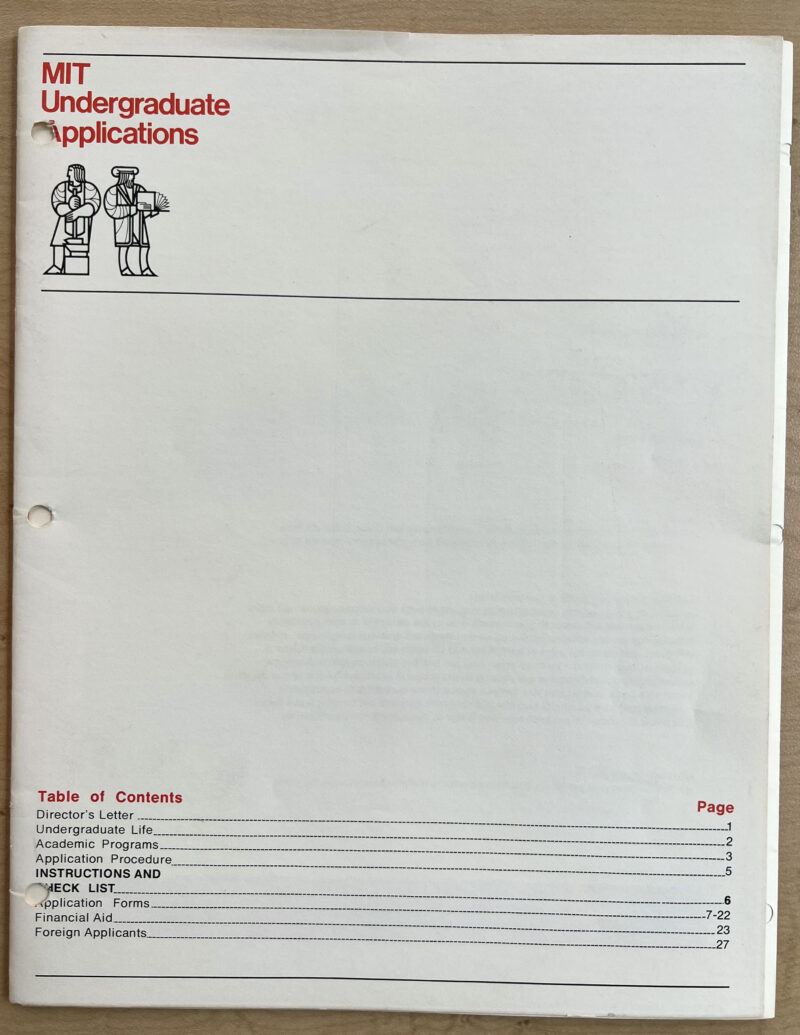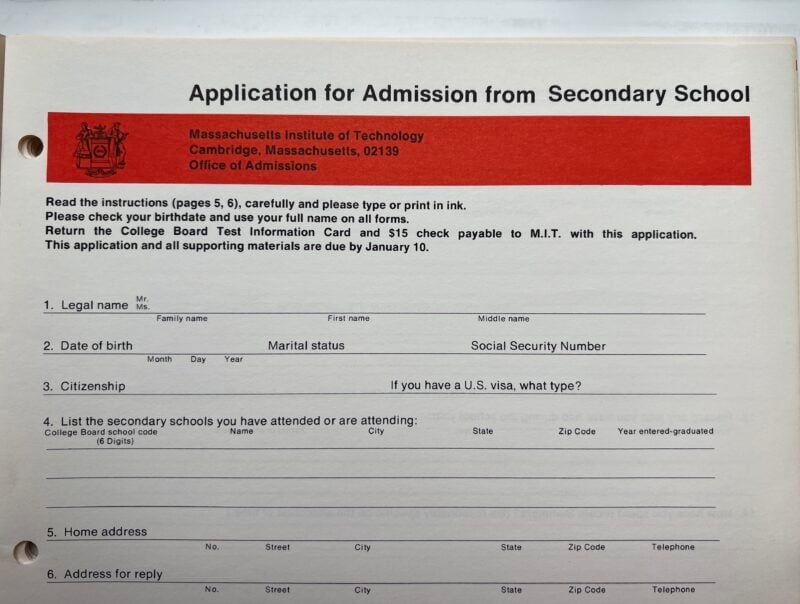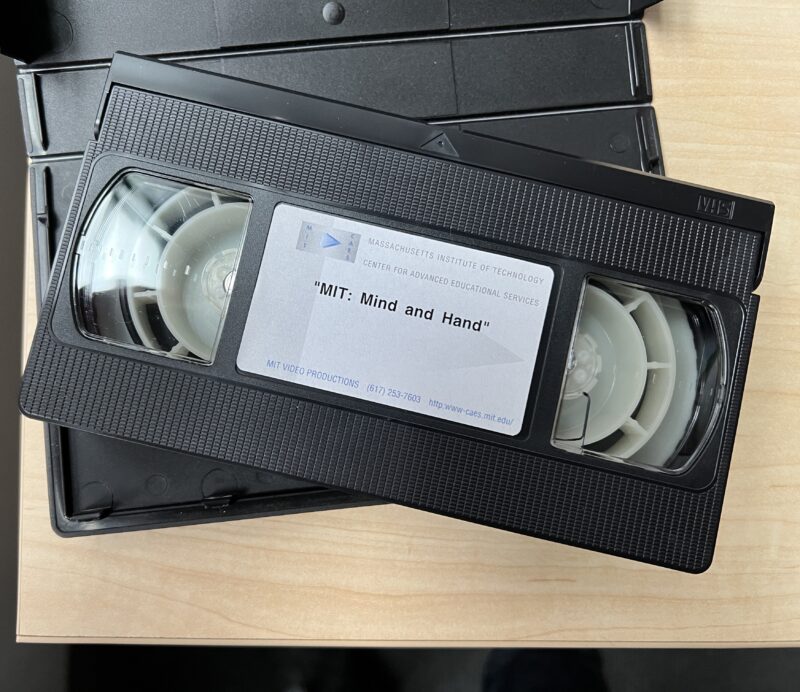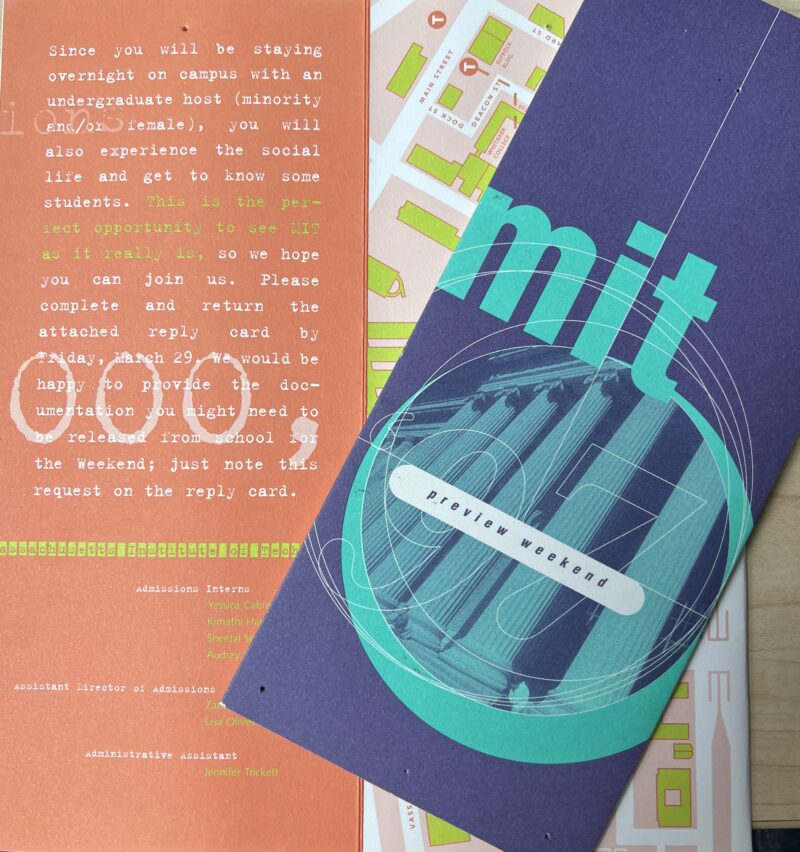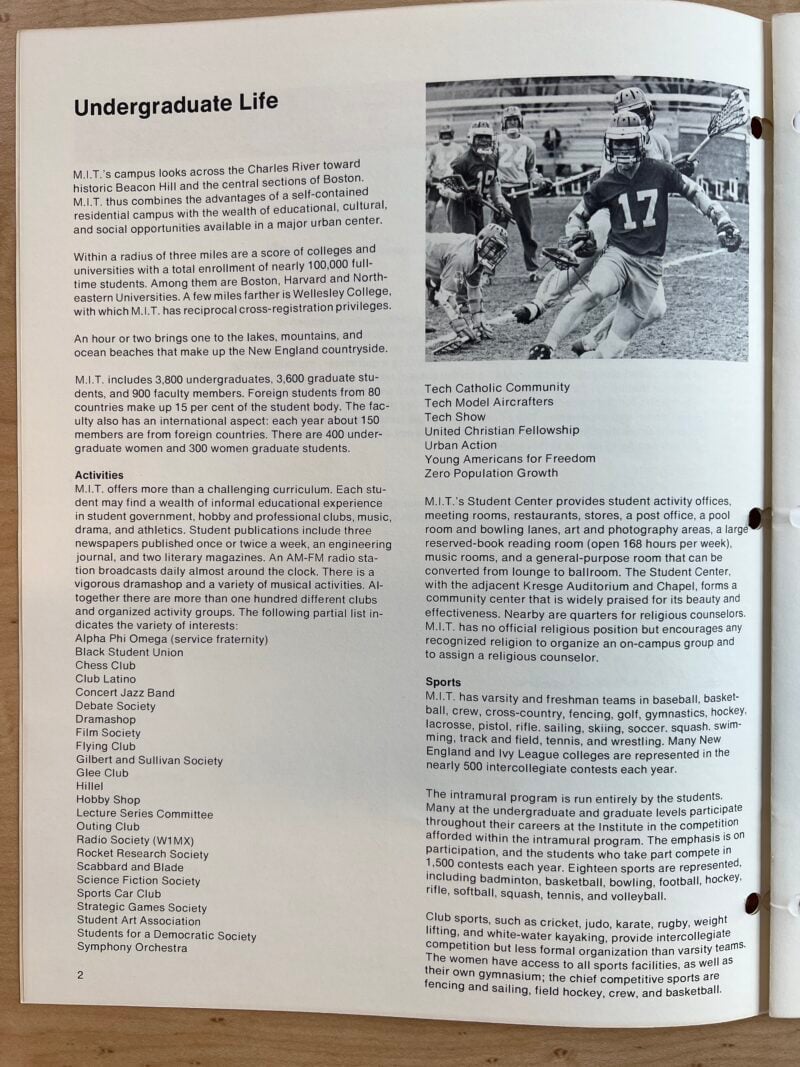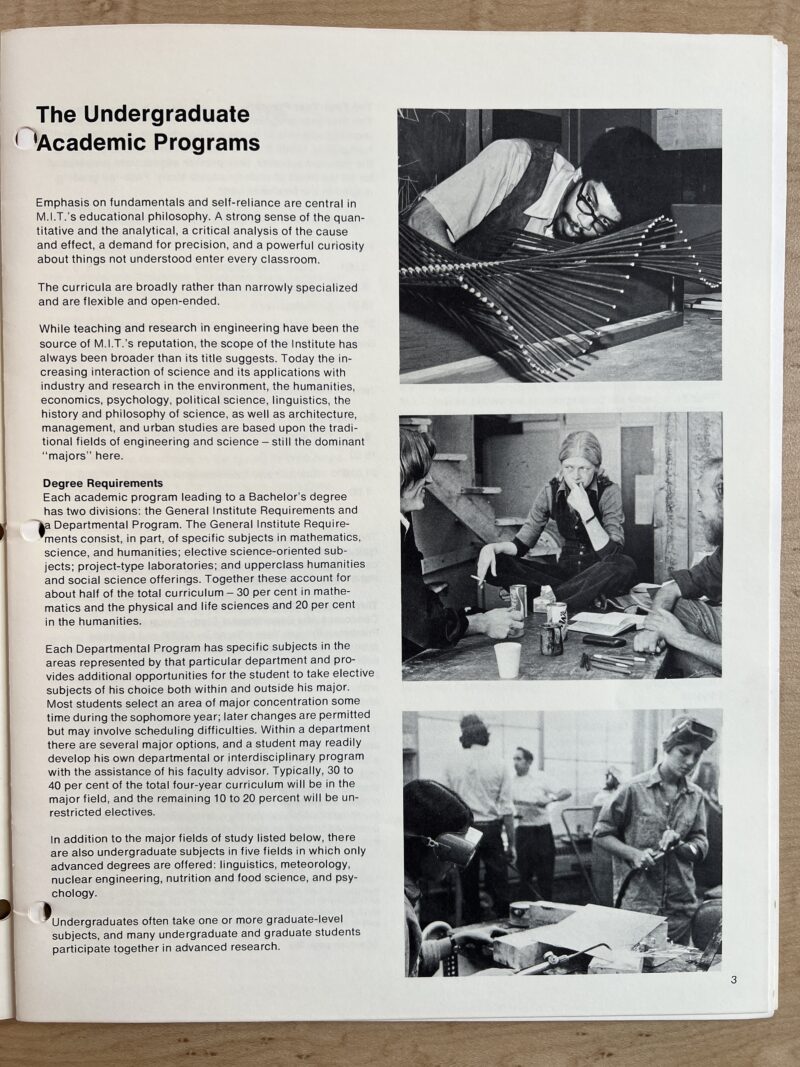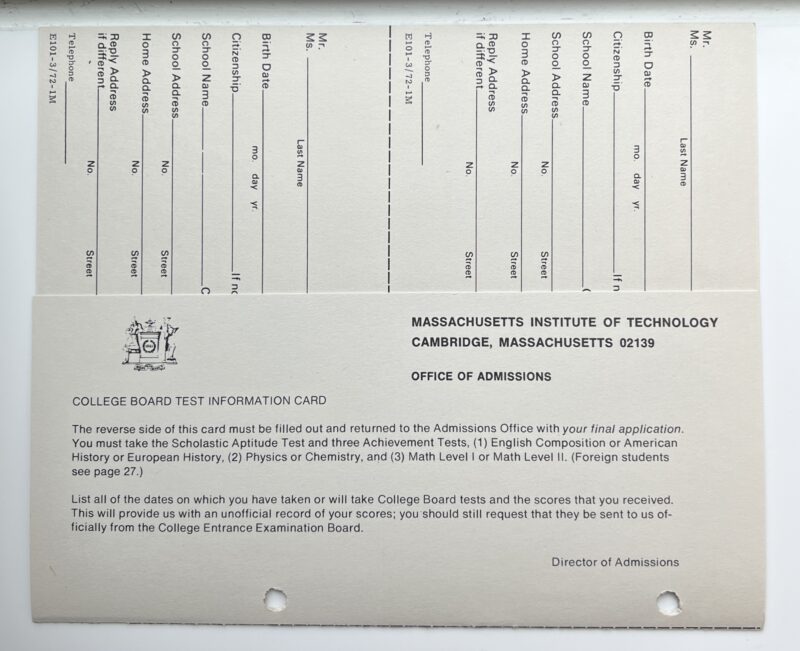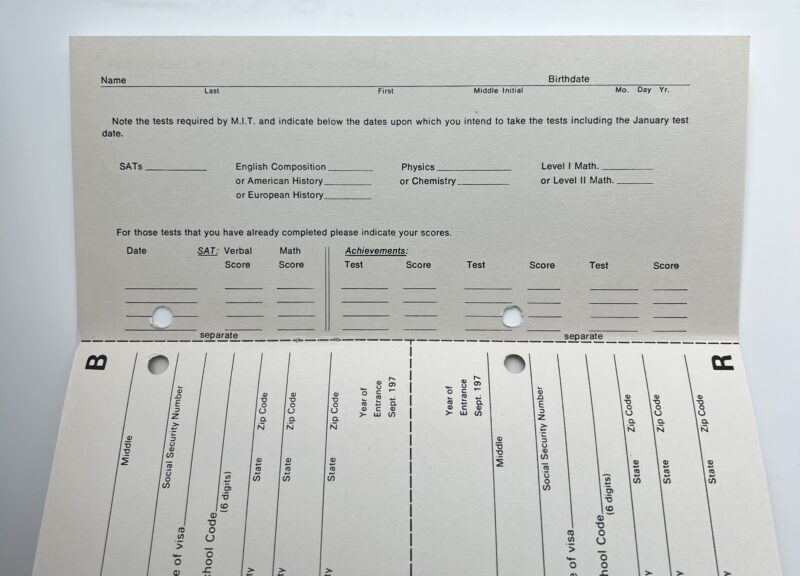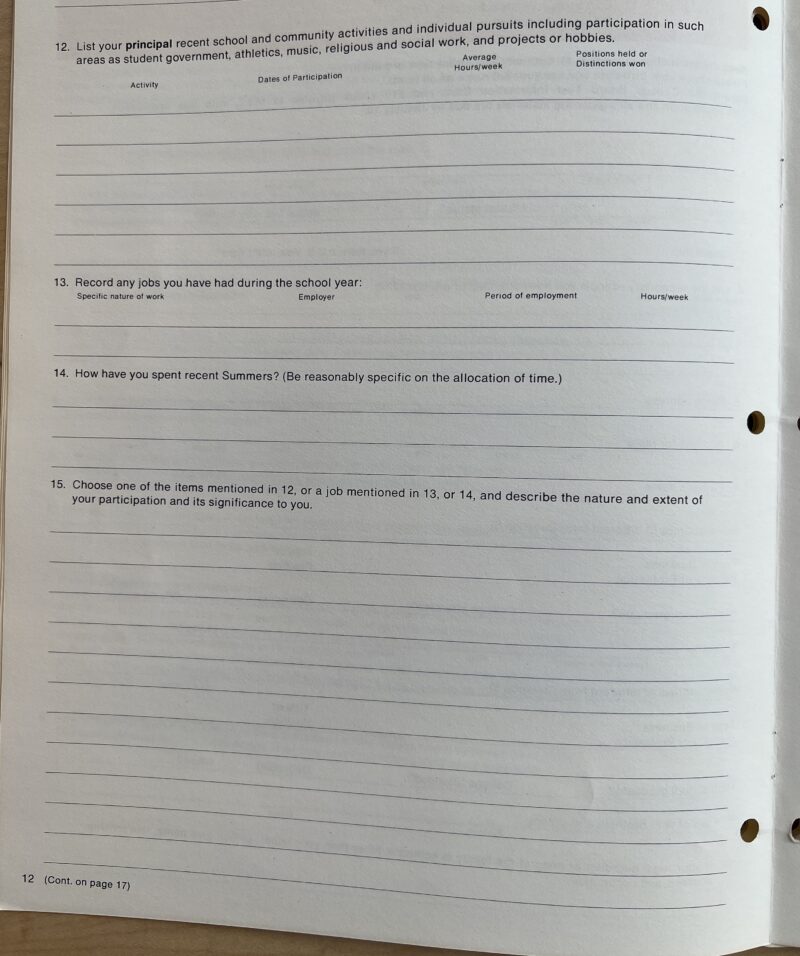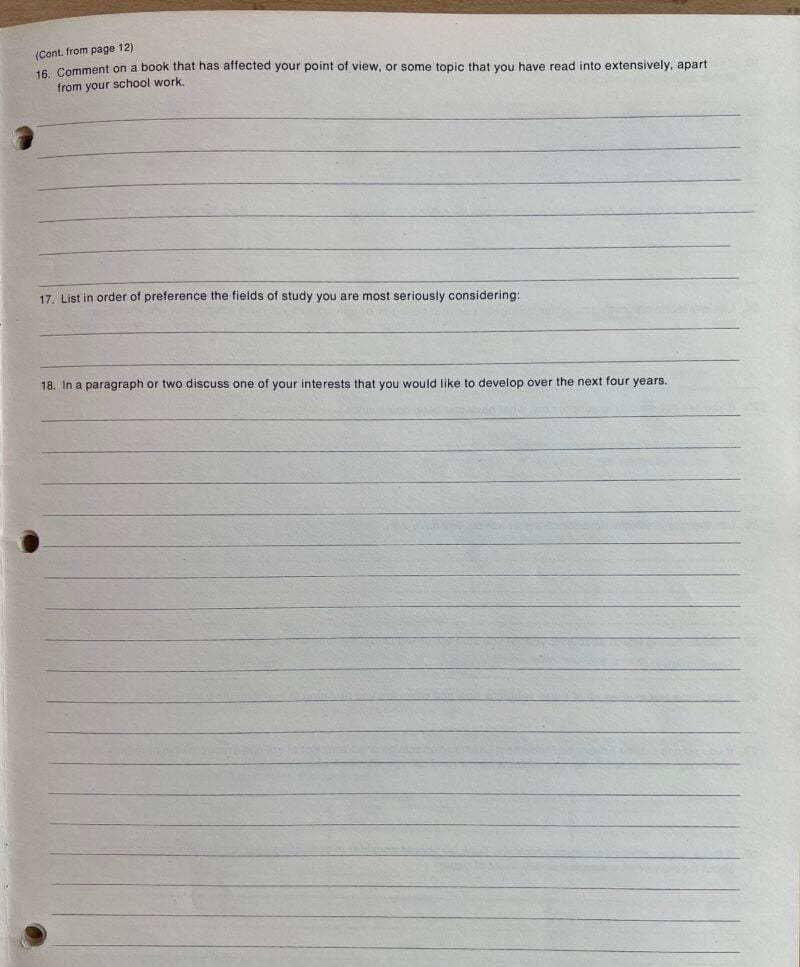
A Half-Century Retrospective by Jeremy W.
Revisiting the MIT Application from the 1972–1973 admissions cycle
Preface
In the process of moving our office from its inaugural location on the Infinite Corridor to its new home in the MIT Welcome Center, I stumbled into some accidental admissions archeology. For nearly a century, for as long as there had been an admissions office at MIT,01 <a href="https://libraries.mit.edu/mithistory/institute/offices/mit-admissions-office/" target="_blank" rel="noopener noreferrer">According to MIT Libraries</a>, the MIT Admissions Office was formally created in 1929, led by the Institute’s first-ever admissions officer, Dr. James Libby Tryon.</span> it was located along the Infinite Corridor. A copy of the MIT Bulletin from 1930 makes reference to the Information Office located in Room 10-100, and until our recent move, 10-100 was the site of the MIT Admissions visitor center. As the admissions office grew, so did our footprint on the Infinite. We eventually went on to occupy the following rooms: 10-100, 3-108, 3-111, 3-103, 3-007, and 3-001.
Anyway, let me set the scene: one day in the summer of 2020—at the height of the campus COVID-19 lockdown—I was permitted to visit the office to clear any personal belongings out of my space in 3-001 before the professional movers got to work. Prohibition style, I met a colleague with authorized campus access at an unmarked service door at the basement level of our building; he ushered me in and we exchanged an awkward hello after having not seen each other in months. “Make it quick,” he remarked, as if we were orchestrating some kind of heist—and like a mysterious oracle, he vanished in an instant. It would be another year until I saw him again in person.
I didn’t make it quick, after all. After spending a few minutes going through all of my stuff, I spent a good hour rummaging through all our old filing cabinets, taking full advantage of being in the office unsupervised. At the bottom of an old metal filing cabinet, I found a trove of vintage MIT relics, everything from a set of vibrant neon Campus Preview Weekend brochures from the 90s, stacks of old MIT Admissions marketing materials, and even a mysterious VHS tape titled MIT: Mind and Hand.02 Does anyone have a VHS player handy? I’d love to see what’s on this tape. I could feel my CJ-historyposting-instincts beginning to tingle.
At the very bottom of the cabinet, I found the most exciting discovery of all: an original copy of the 1973 application to MIT, in perfect condition. I had no choice but to assume this copy of the application had been sitting unnoticed at the bottom of this drawer since the 1970s, waiting to be excavated by some admissions officer 50 years later.
Since this application would have been completed by students in the 1972–1973 application cycle, I thought it would be appropriate to share it with you all now, a half-century later, as the 2022–2023 application cycle is in full swing.
The MIT Application for Admission from Secondary School
Introduction
Set in modernist International Style/Swiss typography—undoubtedly a product of legendary designers Cooper and Casey who led the MIT Office of Design Services—this copy of the 1973 application to MIT is a 30-page printed booklet sent to interested students via first class postal mail. The book consists of the following sections, which include both promotional/informational content, as well as blank application forms for students, teacher recommenders, and school counselors:
- Director’s Letter
- Undergraduate Life
- Academic Programs
- Application Procedure
- Instructions and check list
- Application Forms
- Financial Aid
- Foreign Applicants
One of my favorite parts of the 1973 application is the letter from the Director of Admissions, Peter Hughes Richardson, that greets the applicant on the first page. Peter Richardson served as Director of Admissions from 1972–1984, and coincidentally led the admissions office when Stu Schmill, our current Dean of Admissions, was admitted to MIT! The letter from Director Richardson expertly captures the MIT undergraduate education, even as it exists today.
We are pleased that the undergraduate educational opportunities at M.IT. have attracted your attention.
Our basic approach to the purposes and goals of undergraduate education is characterized by a flexibility and openmindedness that was not evident a few short years ago. Faculty attention and student efforts focus on a style of educational encounter which emphasizes the context of the learning experience—the relationship of teacher and student—as contrasted with the subject matter of that experience. It is clear that no single style of education and no small set of alternative styles is appropriate for our student body with its extraordinary diversity in interests, abilities, preparation, and experience. The primary goal of the faculty is to assist students to arrive at the threshold of educational self-sufficiency and independence. We hope you will decide to join us in this endeavor.
The Admissions Office looks forward to receiving your application, and we at M.I.T. look forward to the coming exchange of information as you make plans for your future.
Sincerely yours,
Peter Richardson
Director of Admissions
Several pages of information about MIT’s academic program and campus life follow the Director’s Letter. I was pleasantly surprised to see so many aspects of contemporary MIT reflected in these pages, including references to the Hobby Shop, Black Students Union, January Independent Activity Period, and MIT Symphony Orchestra.
The application advertises 33 majors for the Bachelor of Science degree, including a few programs no longer offered (like Naval Architecture and Marine Engineering and History, Theory, and Criticism of Visual Arts). Though the number of undergraduate majors MIT offers has nearly doubled since, the essence of the undergraduate program remains unchanged. I was struck by the clarity and concision with which the MIT education is described:
Emphasis on fundamentals and self-reliance are central in M.I.T.’s educational philosophy. A strong sense of the quantitative and the analytical, a critical analysis of the cause and effect, a demand for precision, and a powerful curiosity about things not understood enter every classroom.
And even in the 1970s, MIT was making an effort to shine a light on its esteemed programs in the humanities and social sciences:
While teaching and research in engineering have been the source of M.I.T.’s reputation, the scope of the Institute has always been broader than its title suggests. Today the increasing interaction of science and its applications with industry and research in the environment, the humanities, economics, psychology, political science, linguistics, the history and philosophy of science, as well as architecture, management, and urban studies are based upon the traditional fields of engineering and science—still the dominant “majors” here.
The discussion of the first-year academic program feels largely familiar to the current structure of our current program—with the exception of “pass-fail grading” now taking on a newer form as P/NR (pass/no record).
The first-year program commonly contains electives and required subjects in mathematics, physics, chemistry, and humanities. While there are alternative versions of each of the required subjects, they provide appropriate preparation for all the fields of undergraduate study. Pass-fail grading is used in the freshman year.
The application process
Before the application itself, the booklet provides some general information about the “application procedure,” including application deadlines, recommended high school coursework,03 “Specifically required for entrance are four years of English, mathematics through trigonometry, physics, and chemistry. The precise form of the mathematics curriculum is not important as long as it will prepare a student to go on directly to calculus. Students who have covered the standard topics before their senior year probably should continue by taking either calculus or other more advanced topics in mathematics that may be offered by their school.” and details about their “personal conference” (now known as the interview) with a member of the Educational Council.
In addition to the SAT, MIT required three Achievement Tests (ACH), renamed SAT II: Subject Tests in 2005, in three categories: math, science, and social sciences/humanities:
M.I.T. requires every applicant to take the College Board (C.E.E.B.) tests; the Scholastic Aptitude Test and three Achievement Tests in: 1. Level I or Level II Mathematics, 2. Physics or Chemistry, 3. English Composition or American History and Social Studies or European History and World Cultures. The tests may be taken at any time and any number of times but should be completed not later than January of the senior year.
Though it is now widely known that we release our Regular Action admissions decisions on Pi Day (March 14), that convention—now something of an MIT tradition—didn’t arise until the 2000s. (And it wasn’t even a guaranteed date until a few years later.) Applicants in the 70s applied by the January deadline, and heard back about their decisions in early April.
The Admissions Committee completes the selection of the freshman class early in the spring and most candidates are informed of the decision on their applications in early April.
The 1973 application provides separate instructions for Early Action applicants (they used the same November 1 deadline back then, and also followed a non-binding process), though it seems that the majority of applicants followed the standard timeline that we now call Regular Action.
Early Action
Students who have taken all of the required tests before their senior year have returned all of the application material by November 1, and have made a request in writing will have their applications reviewed by December 1. If their qualifications are so excellent that they are clearly acceptable, an offer of admission will be made. Other applications will be held without prejudice for consideration at the usual time in the spring. A student admitted under this plan is not required to reply to the offer of admission until May 1, the Candidates reply Date.
Other parts of the process have remained unchanged: similar to contemporary policy, students were required to reply to their offer of admission by early May, and students admitted through Early Action are not required (or “bound”) to attend MIT.
Instructions and check list
While today I would tell applicants “There’s no need to apply early and rush your application—apply when you are ready. Just do not wait until the last minute!” the instructions in the 1973 application are a bit more direct. “Complete your application early and avoid the rush.”
INSTRUCTIONS
To remove application forms, open staples at center fold, remove pages 7-22, then reclose staples.
The Application for Admission from Secondary School and the Secondary School Report are 4-page forms. You should separate the Teacher Evaluations and the Financial Aid Application. Also separate the College Board Test Information Card from the two-part Referral Card.
CHECK LIST
Complete your application early and avoid the rush.
1. Return the enclosed referral card at once, if you have not already received instructions about your interview. We will send you the name of a member of the M.I.T. Educational Council with whom you should arrange your conference.
2. Send directly to the Office of Admissions the FINAL APPLICATION FOR ADMISSION together with the $15 APPLICATION FEE made payable to “M.I.T.” Include the CEEB INFORMATION CARD with your Final Application.
3. The required SCHOLASTIC APTITUDE (SAT) AND ACHIEVEMENT TESTS (ACH) should betaken no later than the January 1973 testing date. Foreign students see special instructions on page 27.
4. Give the SECONDARY SCHOOL REPORT FORM to your high school Guidance Counselor. Your counselor will return it directly to M.I.T.
5. Ask two of your teachers to fill out the EVALUATION OF APPLICANT BY TEACHER forms to be returned directly to M.I.T. We suggest you place a stamp on each form.
6. Give the other EVALUATION OF APPLICANT form to a third person. This person should be someone who has worked with you outside of the classroom (perhaps as well as inside the classroom). Again a stamp is sure to be appreciated.
7. If you think you may need financial aid:a) Fill out the APPLICATION FOR FINANCIAL AID and send it directly to the Student Financial Aid Office (M.I.T. Room 5-119) by January 10. You need not apply for aid from specific funds, such as the National Defense Loan Fund. Your aid application will not affect your application for admission; decisions are made by separate committees.b) U.S. and Canadian citizens must submit the PARENTS’ CONFIDENTIAL STATEMENT(PCS) to the College Scholarship Service with the required fee by January 10. Citizens of other countries need not file a PCS.
8. An applicant for EARLY ACTION must have completed all the requirements by November 1, 1972. The applicant must request Early Action in writing when submitting the Final Application.
Application forms
Aside from the application form needing to be typewritten or written in ink, the applicant form from the 70s feels largely consistent with our current application. Just as we do now, the 1973 application asks for a student’s “principal recent school and community activities and individual pursuits including participation in such areas a student government, athletics, music, religions and social work, and projects or hobbies.” Students are also asked to share jobs they’ve held, and information about how they’ve spent their summers. (I appreciate the snarky instructions that state, “Be reasonably specific on the allocation of time.”)
Perhaps the most radical difference I noticed were in some of the “short answer” questions, some that do not have directly analogues on our current application.
16. Comment on a book that has affected your point of view, or some topic that you have read into extensively, apart from your school work.
I love how prompt 16 directs the student to engage in meaningful self-reflection, leading the student to discuss a topic they have explored outside of school work. This prompt sends a clear message that MIT is interested in identifying students who cultivate intellectual interests on their own time—not only when they are required to. While this is still something we value at MIT, we don’t currently have a section of the application that explicitly solicits this information.
17. List in order of preference the fields of study you are most seriously considering:
Prompt 17 is the only question that lives on in similar format on the current application. Today, we ask students to select an area of study at MIT that interests them from a drop-down menu of programs at MIT, and then in 100 words we ask them to elaborate on their interest.
18. In a paragraph or two discuss one of your interests that you would like to develop over the next four years.
Prompt 18 takes a more open-ended approach to a student’s long-term interests in a format that our current application doesn’t quite capture. In today’s application, students often end up inadvertently sharing their long-term goals and interests—whether in a short answer response, in an optional portfolio, or elsewhere—but prompt 18 intentionally invites students to share how their goals intersect with MIT in the longer-term, past the point of admission.
Miscellanea
- Grammatical style: I noticed that this 1970s application always writes out M.I.T. (with periods between each letter). These days, we tend to write the acronym without punctuation, simply MIT. I suspect it was in the 90s, with the advent of the sans serif graphic identity, that we ditched the periods.
- There’s a map of campus printed on the back of the application that I really enjoyed exploring (see below), which included Ashdown House, Bexley Hall, and Senior House. Missing buildings include New House (which would open a few years later in 1975 as New West Campus Houses), Next House (which came online in the early 1980s), and the Stata Center (which wouldn’t be open until 2004).
- Financial aid information included in the booklet probably deserves a separate post of its own. The punchline: tuition in 1973 was estimated at $2,900 per year.

Final (?) thoughts
Who knew that document-based questions (DBQs) from AP World History would one day come in handy? Poring over this 30-page application opened up so many rabbit holes about MIT history that this post has barely scratched the surface of. At this point, I am left grappling with the paradoxical sense that 1972 feels somehow unfathomably distant and incredibly close to 2022.
While much about MIT’s admissions process, the larger landscape of college admissions, and the composition of the MIT student body has changed, it is fascinating that our fundamental approach to both sharing information about this place and identifying its future members has remained the same.
I wonder what the next 50 years will bring for MIT and our admissions office. What essay questions will we be asking, if any at all? Is the future dean of admissions a current undergraduate student right now? Will a researcher at MIT CSAIL design an artificially intelligent system that will render my job obsolete? Or will an admissions officer 50 years from now stumble this blog saved on an old hard drive somewhere in the MIT Welcome Center and laugh?
- According to MIT Libraries, the MIT Admissions Office was formally created in 1929, led by the Institute’s first-ever admissions officer, Dr. James Libby Tryon. back to text ↑
- Does anyone have a VHS player handy? I’d love to see what’s on this tape. back to text ↑
- “Specifically required for entrance are four years of English, mathematics through trigonometry, physics, and chemistry. The precise form of the mathematics curriculum is not important as long as it will prepare a student to go on directly to calculus. Students who have covered the standard topics before their senior year probably should continue by taking either calculus or other more advanced topics in mathematics that may be offered by their school.” back to text ↑
